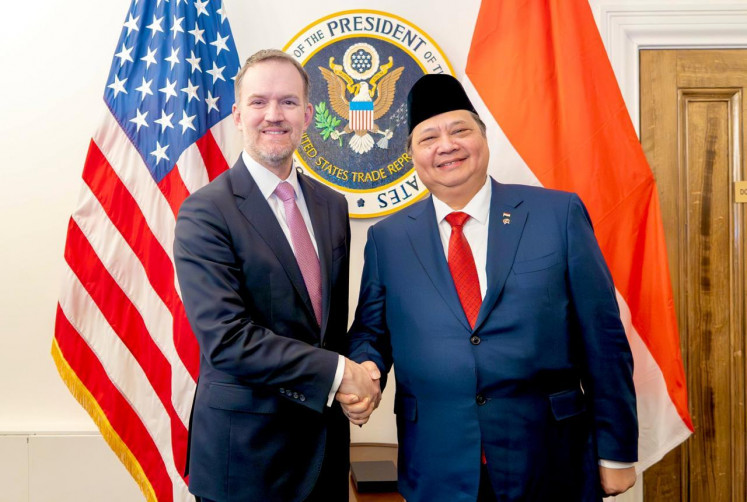Popular Reads
Top Results
Can't find what you're looking for?
View all search resultsPopular Reads
Top Results
Can't find what you're looking for?
View all search resultsProvide incentives for conservation outside protected areas
Protection of forest land inside and outside state forest calls for the strategic roles and strong collaboration of national and local governments, private sector, NGOs and local communities. It is also time for President Joko “Jokowi” Widodo, our leading forester who graduated from forestry studies, to make innovative approaches and actions to save our remaining forest.
Change text size
Gift Premium Articles
to Anyone
 This picture taken on May 9, 2017 shows a team of Indonesian forest rangers making their way through the Leuser ecosystem rainforest, located mostly within the province of Aceh on the northern tip of the island of Sumatra. Scientists and conservationists consider the Leuser Ecosystem to be among the most important forests left in Southeast Asia, particularly because it is the last place of sufficient size and quality to support viable populations of rare species like Sumatran tigers, orangutans, rhinos, elephants, clouded leopards and sun bears. (AFP/Chaideer Mahyuddin)
This picture taken on May 9, 2017 shows a team of Indonesian forest rangers making their way through the Leuser ecosystem rainforest, located mostly within the province of Aceh on the northern tip of the island of Sumatra. Scientists and conservationists consider the Leuser Ecosystem to be among the most important forests left in Southeast Asia, particularly because it is the last place of sufficient size and quality to support viable populations of rare species like Sumatran tigers, orangutans, rhinos, elephants, clouded leopards and sun bears. (AFP/Chaideer Mahyuddin)
T
he policy of the Environment and Forestry Ministry to encourage regional governments to ensure non-state forest areas (APL) to have good forest cover and high biodiversity values as essential ecosystem areas (KEE) has received warm response from conservation NGOs.
Even though the concept of essential ecosystem areas (KEE) has yet been supported by national regulatory framework, now nearly 1 million hectares of land largely outside state forest land, have been designated as 45 KEE units. They comprise 27 biodiversity parks covering 0.2 percent, one high conservation value (HCV) area covering 0.01 percent, three karst ecosystems covering 57 percent, seven mangrove forests covering 0.7 percent, and seven wildlife corridors covering 42 percent of the area. The biodiversity parks, the HCV area and the wildlife corridor are outside state forest areas while karst and mangrove ecosystem are inside forest areas, aimed to strengthen protection status since KEE is managed inclusively through multi-stakeholder platform.
However, since the larger part of KEE area is outside state forests, legal issues remain, leading to uncertainty on which authority will supervise areas preserved for conservation. We will see this legal vacuum until at least the end of the current cabinet.
The above ministry draft on the KEE clearly states the KEE does not change land tenure status. However, many suspect it would curtail production activities.
Saving remaining forested areas, outside or even within state forest areas is a tall order – “conserved” forest areas are mostly located in non-accessible areas or those with little economic values.
Despite awareness of the importance of preserving intact forest ecosystems as natural capital to protect production landscape, implementation is strife with challenges. Indigenous people living in and around forests experience rapid social changes amid subsistence needs to shift to more market-oriented needs, so they are continuously forced to convert forests.
So far, the strongest KEE proponent is large-scale palm oil companies that have made a “no-deforestation, no peat, no exploitation” pledge to protect areas of high conservation value and high carbon stock areas, to voluntarily commit to certification schemes driven by the international market. However, the commitment may decline over time with the volatile changes of international market policy of Indonesian oil-palm products.
Some innovative and progressive incentives need to be developed to implement KEE. First, increase balancing funds from the central government, by increasing the general allocation fund (DAU) and special allocation fund (DAK, for forest rehabilitation and restoration) to regional governments which commit to protect their forested areas, especially those where large parts of their territory have been designated as state forest areas, limiting their source of profit and tax revenues.
This is the case for many regencies in Kalimantan and Papua. The regencies should also receive special treatment, especially to regain their authority to manage their forests as this authority was transferred to the provincial level through the 2014 law on regional governance, on the condition that the provinces are committed to protect their forested areas.
Second, the central government needs to provide ecological fiscal transfer to regency administrations and local communities committed to protect their forests, based on the government regulation No.46/2017 on the environmental economic instruments. These transfers should again be based on performance.
Third, concession holders who identify, allocate and manage areas of high conservation value and high carbon stock in their concession areas (HGU) should be exempt from property and land taxes (PBB) although local and national governments mostly rely on PBB revenue.
Meanwhile, NGOs can help ensure that compensation funds of the Roundtable on Sustainable Palm Oil (RSPO) are used to incentivize local communities who protect their forests. The RSPO acknowledges some non-compliant land clearance of large-scale plantations has occurred since November 2005. Rather than imposing immediate penalties, including suspension or barring grower members from certification, RSPO developed the “remediation and compensation procedure”, a mechanism to compensate cleared areas of high conservation value.
Based on land-use change analysis, the initial assessment of the non-compliant land clearance of large-scale palm oil plantation in Indonesia was 692,207 hectares according to the RSPO. With a compensation cost for the lost high conservation value areas estimated at US$2,500 per ha, this would be a huge fund to serve as incentives for community forests which have been designated as essential ecosystem areas.
Protection of forest land inside and outside state forest calls for the strategic roles and strong collaboration of national and local governments, private sector, NGOs and local communities. It is also time for President Joko “Jokowi” Widodo, our leading forester who graduated from forestry studies, to make innovative approaches and actions to save our remaining forests.
***
Director, Yayasan Tropenbos Indonesia









